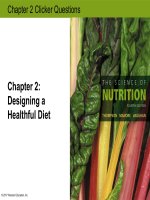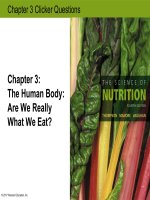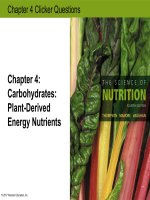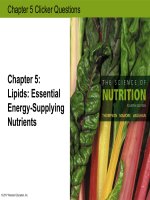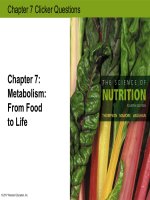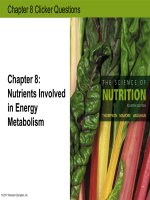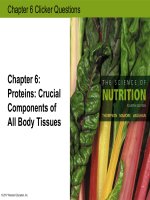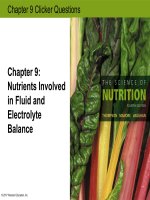Clicker questions the science of NUTRITON 4th by thompson manore and vaughan chapter 07
Bạn đang xem bản rút gọn của tài liệu. Xem và tải ngay bản đầy đủ của tài liệu tại đây (338.09 KB, 21 trang )
Chapter 8 Clicker Questions
Chapter 8:
Nutrients Involved
in Energy
Metabolism
© 2017 Pearson Education, Inc.
The B-vitamins
a)
b)
c)
d)
© 2017 Pearson Education, Inc.
act as enzymes essential for energy metabolism.
act as coenzymes to promote energy metabolism.
act as energy-yielding micronutrients.
are essential to the synthesis of thyroid hormones and the regulation of metabolic rate.
The B-vitamins
a)
b)
c)
d)
© 2017 Pearson Education, Inc.
act as enzymes essential for energy metabolism.
act as coenzymes to promote energy metabolism.
act as energy-yielding micronutrients.
are essential to the synthesis of thyroid hormones and the regulation of metabolic rate.
Vitamins required for the oxidation-reduction reactions involved in the catabolism of
carbohydrates, fats, and proteins for energy include
a)
b)
c)
d)
© 2017 Pearson Education, Inc.
thiamin and riboflavin, but not niacin.
thiamin and niacin, but not riboflavin.
riboflavin and niacin, but not thiamin.
thiamin, riboflavin, and niacin.
Vitamins required for the oxidation-reduction reactions involved in the catabolism of
carbohydrates, fats, and proteins for energy include
a)
b)
c)
d)
© 2017 Pearson Education, Inc.
thiamin and riboflavin, but not niacin.
thiamin and niacin, but not riboflavin.
riboflavin and niacin, but not thiamin.
thiamin, riboflavin, and niacin.
Niacin-deficiency disease is called
a)
b)
c)
d)
© 2017 Pearson Education, Inc.
flushing.
marasmus.
pellagra.
beriberi.
Niacin-deficiency disease is called
a)
b)
c)
d)
© 2017 Pearson Education, Inc.
flushing.
marasmus.
pellagra.
beriberi.
A coenzyme assisting in the breakdown of stored glycogen to glucose and in the
conversion of amino acids to glucose is
a)
b)
c)
d)
© 2017 Pearson Education, Inc.
vitamin B6.
folate.
vitamin B12.
vitamin B6, folate, and vitamin B12.
A coenzyme assisting in the breakdown of stored glycogen to glucose and in the
conversion of amino acids to glucose is
a)
b)
c)
d)
© 2017 Pearson Education, Inc.
vitamin B6.
folate.
vitamin B12.
vitamin B6, folate, and vitamin B12.
High blood levels of the amino acid homocysteine are associated with
a)
b)
c)
d)
© 2017 Pearson Education, Inc.
high blood levels of the amino acid methionine.
vitamin B6, folate, and vitamin B12 toxicity.
an increased risk for cardiovascular disease.
an increased risk for neural tube defects.
High blood levels of the amino acid homocysteine are associated with
a)
b)
c)
d)
© 2017 Pearson Education, Inc.
high blood levels of the amino acid methionine.
vitamin B6, folate, and vitamin B12 toxicity.
an increased risk for cardiovascular disease.
an increased risk for neural tube defects.
Adequate folate intake is essential during early
pregnancy because
a)
b)
c)
d)
© 2017 Pearson Education, Inc.
folate deficiency masks a simultaneous vitamin B12 deficiency.
folate is critical for cell division.
maternal folate deficiency increases the risk of cretinism.
folate helps maintain the myelin sheath coating nerve fibers.
Adequate folate intake is essential during early
pregnancy because
a)
b)
c)
d)
© 2017 Pearson Education, Inc.
folate deficiency masks a simultaneous vitamin B12 deficiency.
folate is critical for cell division.
maternal folate deficiency increases the risk of cretinism.
folate helps maintain the myelin sheath coating nerve fibers.
Which of the following statements about choline is true?
a)
b)
c)
d)
Choline is found exclusively in foods of animal origin.
Choline is a B-vitamin that assists in carbohydrate metabolism.
Choline is a neurotransmitter that is involved in muscle movement and memory storage.
Choline is a vitamin-like compound necessary
for homocysteine metabolism and the
synthesis of bile.
© 2017 Pearson Education, Inc.
Which of the following statements about choline is true?
a)
b)
c)
d)
Choline is found exclusively in foods of animal origin.
Choline is a B-vitamin that assists in carbohydrate metabolism.
Choline is a neurotransmitter that is involved in muscle movement and memory storage.
Choline is a vitamin-like compound necessary for homocysteine metabolism and
the synthesis of bile.
© 2017 Pearson Education, Inc.
A trace mineral that plays an important role in carbohydrate metabolism, glucose
transport into cells, RNA and DNA metabolism, immune function, and growth is
a)
b)
c)
d)
© 2017 Pearson Education, Inc.
iodine.
chromium.
manganese.
sulfur.
A trace mineral that plays an important role in carbohydrate metabolism, glucose
transport into cells, RNA and DNA metabolism, immune function, and growth is
a)
b)
c)
d)
© 2017 Pearson Education, Inc.
iodine.
chromium.
manganese.
sulfur.
According to the World Health Organization (WHO), the greatest single cause of
preventable brain damage and mental retardation in the world is
a)
b)
c)
d)
© 2017 Pearson Education, Inc.
iodine deficiency.
chromium deficiency.
manganese deficiency.
sulfur deficiency.
According to the World Health Organization (WHO), the greatest single cause of
preventable brain damage and mental retardation in the world is
a)
b)
c)
d)
© 2017 Pearson Education, Inc.
iodine deficiency.
chromium deficiency.
manganese deficiency.
sulfur deficiency.
Research has consistently shown that individuals with poor B-vitamin status
a)
have a reduced ability to perform physical activity involving intense bursts of energy, such
as sprinting, but not endurance activity, such as running.
b)
have a reduced ability to perform endurance activity, such as running, but not physical
activity involving intense bursts of energy, such as sprinting.
c)
d)
© 2017 Pearson Education, Inc.
have a reduced ability to perform most types of physical activity.
have a greatly increased risk of musculoskeletal injury with physical activity.
Research has consistently shown that individuals with poor B-vitamin status
a)
have a reduced ability to perform physical activity involving intense bursts of energy, such
as sprinting, but not endurance activity, such as running.
b)
have a reduced ability to perform endurance activity, such as running, but not physical
activity involving intense bursts of energy, such as sprinting.
c)
d)
© 2017 Pearson Education, Inc.
have a reduced ability to perform most types of physical activity.
have a greatly increased risk of musculoskeletal injury with physical activity.

